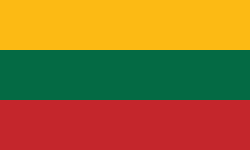Plungė
 |
 |
It has a crab stick factory which exports to many countries in Europe.
It is thought that the territory in which Plungė is situated was inhabited in 5th–1st centuries BC. After the Treaty of Melno country seats were established in the forests of Samogitia. From the 14th century to the middle of the 16th century, Plungė was a part of Gandinga district as an ordinary settlement. Later, the population of Plungė started to grow faster and surpassed the population of Gandinga. In 1567 Plungė was mentioned as a town.
On January 13, 1792, Plungė was granted Magdeburg rights. From 1806 to 1873 Plungė belonged to Platon Zubov, and later – to Oginskiai, who built a palace here in 1879.
During the interwar period there was established gymnasium in 1925 and built railway branch-line in 1932. In 1933 current Catholic Church was consecrated. Since the private hospital was founded in 1939, maternity, surgical sections started their activities. Lithuanian Jews were active in the town's government and comprised around half of Plungė's inhabitants leading up to The Holocaust in Lithuania.
During the 1941 June Uprising in Lithuania and the German invasion as part of Operation Barbarossa, Plungė was captured by German forces on 25 June 1941. Lithuanian nationalists, led by Jonas Noreika, seized control and formed a town administration and police force. German forces killed 60 young Jewish men, accused by the Lithuanians of being a rear guard for the Red Army, shortly after the town's capture. On 26 June 1941, the day after the Germans' arrival in Plungė, Lithuanian forces moved the town's Jews into a makeshift ghetto, while carrying out beatings, torture, murders and forcing Jews to perform heavy labor. On 13 or 15 July in the Plungė massacre, the Lithuanian nationalists transported Jewish men, women and children to ditches near the village of Kausenai where they were shot. Of the 1,700 Jews living in Plungė in 1939, very few survived and often those who were victims of the Soviet deportations from Lithuania prior to the Holocaust. Remembrance sites for the events of 1941 exist in and around the town. The Jewish holocaust survivor and sculptor Jacob Bunka was one of the town's few Jews to survive the war.
During the years of the independence of Lithuania Plungė's economic was based on the factory of fibre flax and cotton Kučiskis – Pabedinskiai and also on the activities of Jewish businessmen and agricultural products made by Samogitian farmers.
After World War II and the Soviet occupation, Plungė started to grow rapidly – if the city had 7,400 inhabitants in 1950, in 1990 it had already had 23,300 inhabitants. During the years of Soviet occupation, Lithuanians became the majority of city's inhabitants. According to Government's Resolution of 1963, Plungė should have become regional centre with a strong industry. However these plans were ruined when it became obvious that the city doesn't have enough water resources although some high level companies representing various branches of industry were established in Plungė. Most of these companies however bankrupted after the Independence of Lithuania was announced.
The coat of arms of Plungė was affirmed by the decree of the President on June 6, 1997. In 2009 Plungė was elected Lithuanian Capital of Culture. Nowadays Plungė is the sixteenth largest city of Lithuania having 22,287 inhabitants.
Map - Plungė
Map
Country - Lithuanian_Soviet_Socialist_Republic_(1918–1919)
 |
 |
| Flag of Lithuania | |
Germany had lost World War I and signed the Compiègne Armistice on 11 November 1918. Its military forces then started retreating from the former Ober Ost territories. Two days later, the government of the Soviet Russia renounced the Treaty of Brest-Litovsk, which had assured Lithuania's independence. Soviet forces then launched a westward offensive against Estonia, Latvia, Lithuania, Poland and Ukraine in an effort to spread the global proletarian revolution and replace national independence movements with Soviet republics. Their forces followed retreating German troops and reached Lithuania by the end of December 1918.
Currency / Language
| ISO | Currency | Symbol | Significant figures |
|---|---|---|---|
| EUR | Euro | € | 2 |
| ISO | Language |
|---|---|
| LT | Lithuanian language |
| PL | Polish language |
| RU | Russian language |















